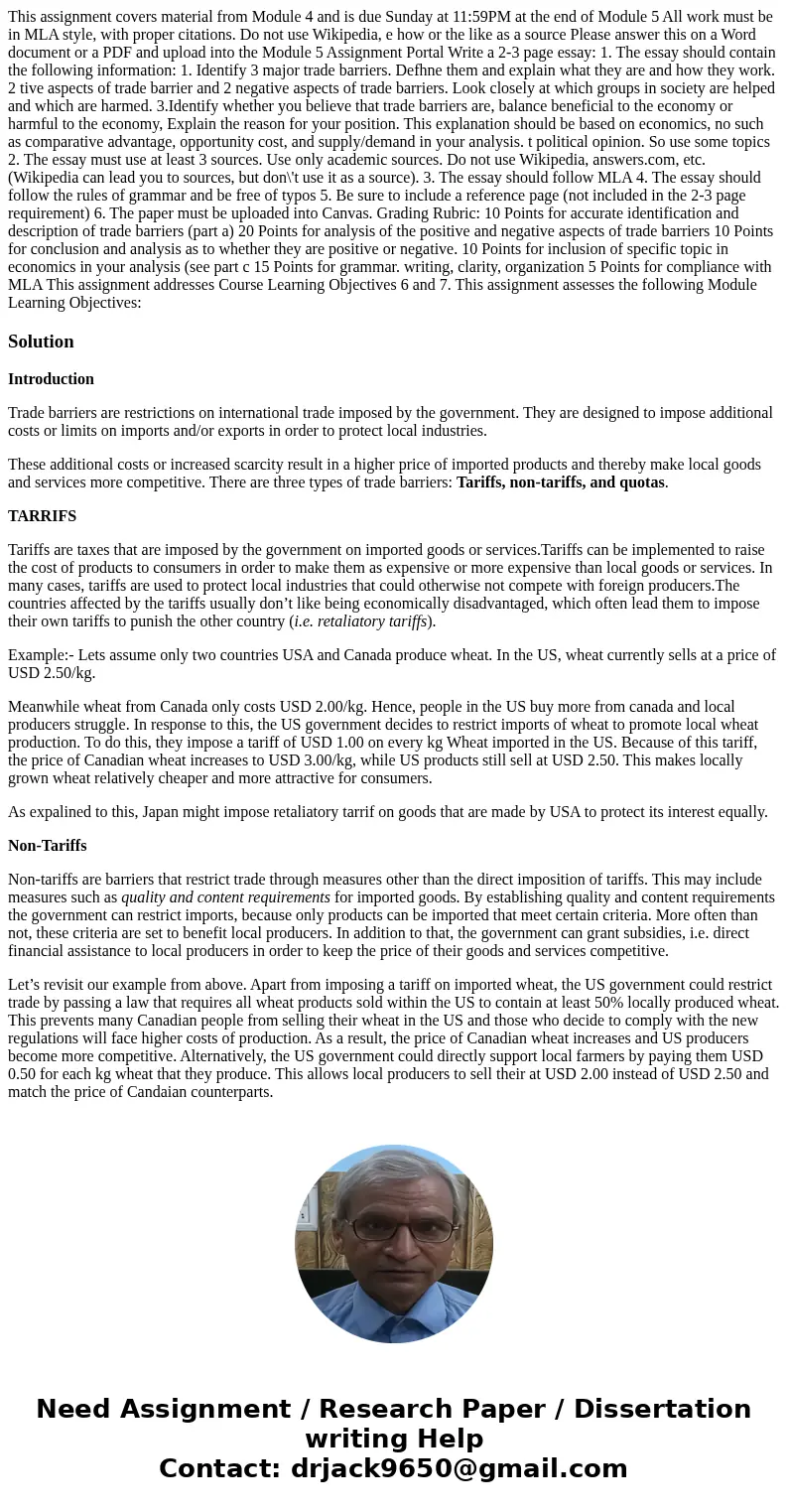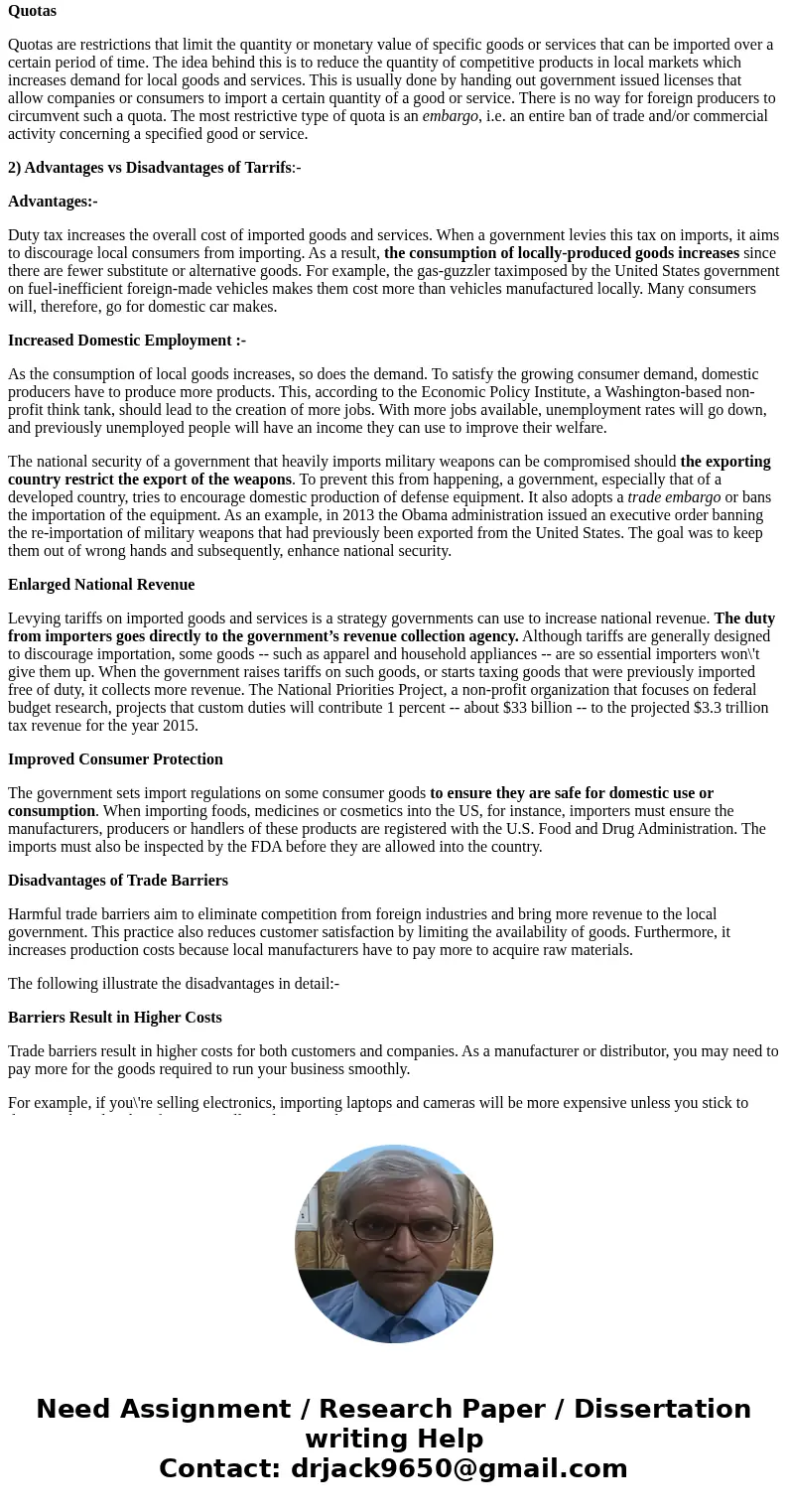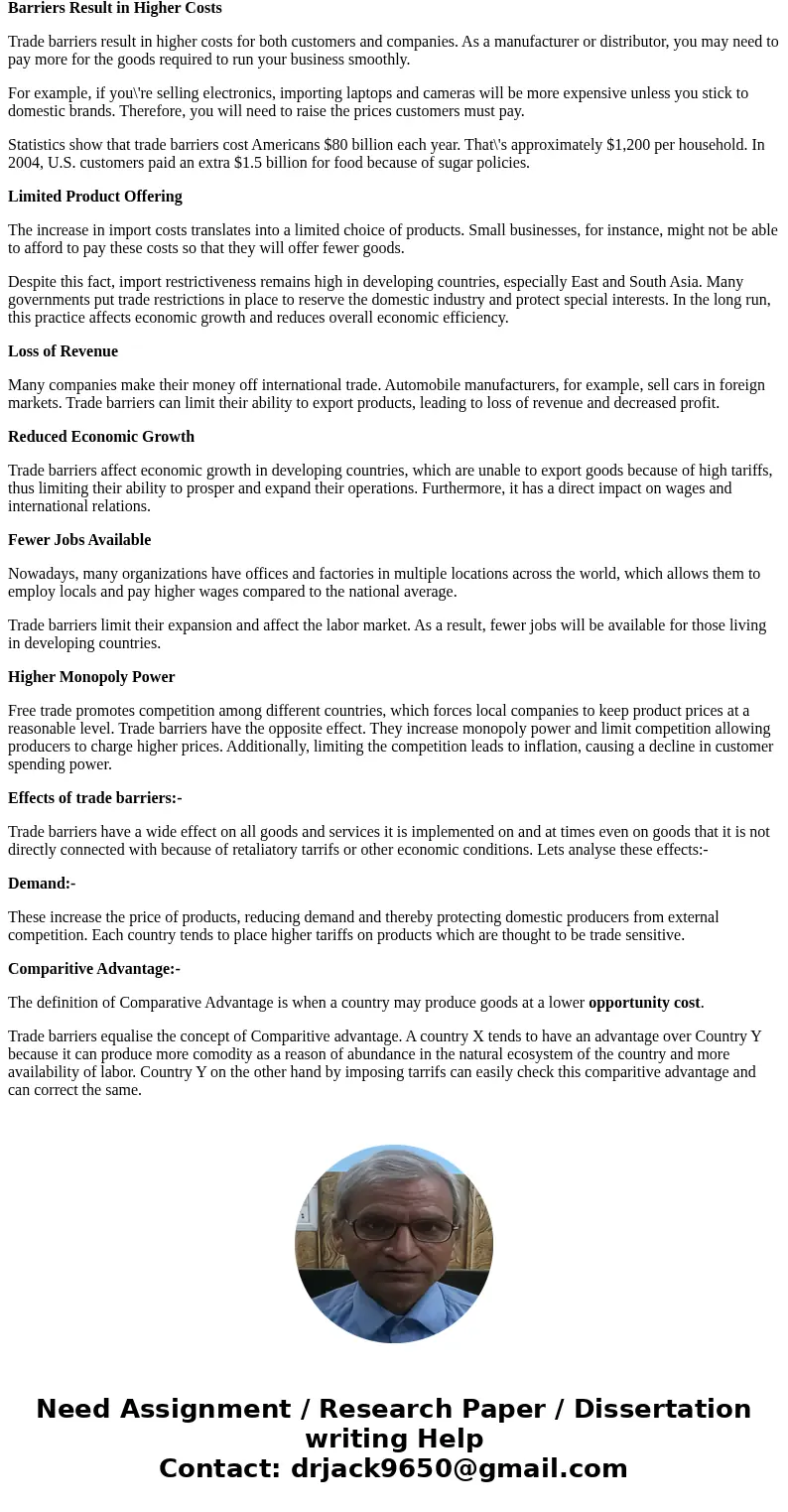This assignment covers material from Module 4 and is due Sun
Solution
Introduction
Trade barriers are restrictions on international trade imposed by the government. They are designed to impose additional costs or limits on imports and/or exports in order to protect local industries.
These additional costs or increased scarcity result in a higher price of imported products and thereby make local goods and services more competitive. There are three types of trade barriers: Tariffs, non-tariffs, and quotas.
TARRIFS
Tariffs are taxes that are imposed by the government on imported goods or services.Tariffs can be implemented to raise the cost of products to consumers in order to make them as expensive or more expensive than local goods or services. In many cases, tariffs are used to protect local industries that could otherwise not compete with foreign producers.The countries affected by the tariffs usually don’t like being economically disadvantaged, which often lead them to impose their own tariffs to punish the other country (i.e. retaliatory tariffs).
Example:- Lets assume only two countries USA and Canada produce wheat. In the US, wheat currently sells at a price of USD 2.50/kg.
Meanwhile wheat from Canada only costs USD 2.00/kg. Hence, people in the US buy more from canada and local producers struggle. In response to this, the US government decides to restrict imports of wheat to promote local wheat production. To do this, they impose a tariff of USD 1.00 on every kg Wheat imported in the US. Because of this tariff, the price of Canadian wheat increases to USD 3.00/kg, while US products still sell at USD 2.50. This makes locally grown wheat relatively cheaper and more attractive for consumers.
As expalined to this, Japan might impose retaliatory tarrif on goods that are made by USA to protect its interest equally.
Non-Tariffs
Non-tariffs are barriers that restrict trade through measures other than the direct imposition of tariffs. This may include measures such as quality and content requirements for imported goods. By establishing quality and content requirements the government can restrict imports, because only products can be imported that meet certain criteria. More often than not, these criteria are set to benefit local producers. In addition to that, the government can grant subsidies, i.e. direct financial assistance to local producers in order to keep the price of their goods and services competitive.
Let’s revisit our example from above. Apart from imposing a tariff on imported wheat, the US government could restrict trade by passing a law that requires all wheat products sold within the US to contain at least 50% locally produced wheat. This prevents many Canadian people from selling their wheat in the US and those who decide to comply with the new regulations will face higher costs of production. As a result, the price of Canadian wheat increases and US producers become more competitive. Alternatively, the US government could directly support local farmers by paying them USD 0.50 for each kg wheat that they produce. This allows local producers to sell their at USD 2.00 instead of USD 2.50 and match the price of Candaian counterparts.
Quotas
Quotas are restrictions that limit the quantity or monetary value of specific goods or services that can be imported over a certain period of time. The idea behind this is to reduce the quantity of competitive products in local markets which increases demand for local goods and services. This is usually done by handing out government issued licenses that allow companies or consumers to import a certain quantity of a good or service. There is no way for foreign producers to circumvent such a quota. The most restrictive type of quota is an embargo, i.e. an entire ban of trade and/or commercial activity concerning a specified good or service.
2) Advantages vs Disadvantages of Tarrifs:-
Advantages:-
Duty tax increases the overall cost of imported goods and services. When a government levies this tax on imports, it aims to discourage local consumers from importing. As a result, the consumption of locally-produced goods increases since there are fewer substitute or alternative goods. For example, the gas-guzzler taximposed by the United States government on fuel-inefficient foreign-made vehicles makes them cost more than vehicles manufactured locally. Many consumers will, therefore, go for domestic car makes.
Increased Domestic Employment :-
As the consumption of local goods increases, so does the demand. To satisfy the growing consumer demand, domestic producers have to produce more products. This, according to the Economic Policy Institute, a Washington-based non-profit think tank, should lead to the creation of more jobs. With more jobs available, unemployment rates will go down, and previously unemployed people will have an income they can use to improve their welfare.
The national security of a government that heavily imports military weapons can be compromised should the exporting country restrict the export of the weapons. To prevent this from happening, a government, especially that of a developed country, tries to encourage domestic production of defense equipment. It also adopts a trade embargo or bans the importation of the equipment. As an example, in 2013 the Obama administration issued an executive order banning the re-importation of military weapons that had previously been exported from the United States. The goal was to keep them out of wrong hands and subsequently, enhance national security.
Enlarged National Revenue
Levying tariffs on imported goods and services is a strategy governments can use to increase national revenue. The duty from importers goes directly to the government’s revenue collection agency. Although tariffs are generally designed to discourage importation, some goods -- such as apparel and household appliances -- are so essential importers won\'t give them up. When the government raises tariffs on such goods, or starts taxing goods that were previously imported free of duty, it collects more revenue. The National Priorities Project, a non-profit organization that focuses on federal budget research, projects that custom duties will contribute 1 percent -- about $33 billion -- to the projected $3.3 trillion tax revenue for the year 2015.
Improved Consumer Protection
The government sets import regulations on some consumer goods to ensure they are safe for domestic use or consumption. When importing foods, medicines or cosmetics into the US, for instance, importers must ensure the manufacturers, producers or handlers of these products are registered with the U.S. Food and Drug Administration. The imports must also be inspected by the FDA before they are allowed into the country.
Disadvantages of Trade Barriers
Harmful trade barriers aim to eliminate competition from foreign industries and bring more revenue to the local government. This practice also reduces customer satisfaction by limiting the availability of goods. Furthermore, it increases production costs because local manufacturers have to pay more to acquire raw materials.
The following illustrate the disadvantages in detail:-
Barriers Result in Higher Costs
Trade barriers result in higher costs for both customers and companies. As a manufacturer or distributor, you may need to pay more for the goods required to run your business smoothly.
For example, if you\'re selling electronics, importing laptops and cameras will be more expensive unless you stick to domestic brands. Therefore, you will need to raise the prices customers must pay.
Statistics show that trade barriers cost Americans $80 billion each year. That\'s approximately $1,200 per household. In 2004, U.S. customers paid an extra $1.5 billion for food because of sugar policies.
Limited Product Offering
The increase in import costs translates into a limited choice of products. Small businesses, for instance, might not be able to afford to pay these costs so that they will offer fewer goods.
Despite this fact, import restrictiveness remains high in developing countries, especially East and South Asia. Many governments put trade restrictions in place to reserve the domestic industry and protect special interests. In the long run, this practice affects economic growth and reduces overall economic efficiency.
Loss of Revenue
Many companies make their money off international trade. Automobile manufacturers, for example, sell cars in foreign markets. Trade barriers can limit their ability to export products, leading to loss of revenue and decreased profit.
Reduced Economic Growth
Trade barriers affect economic growth in developing countries, which are unable to export goods because of high tariffs, thus limiting their ability to prosper and expand their operations. Furthermore, it has a direct impact on wages and international relations.
Fewer Jobs Available
Nowadays, many organizations have offices and factories in multiple locations across the world, which allows them to employ locals and pay higher wages compared to the national average.
Trade barriers limit their expansion and affect the labor market. As a result, fewer jobs will be available for those living in developing countries.
Higher Monopoly Power
Free trade promotes competition among different countries, which forces local companies to keep product prices at a reasonable level. Trade barriers have the opposite effect. They increase monopoly power and limit competition allowing producers to charge higher prices. Additionally, limiting the competition leads to inflation, causing a decline in customer spending power.
Effects of trade barriers:-
Trade barriers have a wide effect on all goods and services it is implemented on and at times even on goods that it is not directly connected with because of retaliatory tarrifs or other economic conditions. Lets analyse these effects:-
Demand:-
These increase the price of products, reducing demand and thereby protecting domestic producers from external competition. Each country tends to place higher tariffs on products which are thought to be trade sensitive.
Comparitive Advantage:-
The definition of Comparative Advantage is when a country may produce goods at a lower opportunity cost.
Trade barriers equalise the concept of Comparitive advantage. A country X tends to have an advantage over Country Y because it can produce more comodity as a reason of abundance in the natural ecosystem of the country and more availability of labor. Country Y on the other hand by imposing tarrifs can easily check this comparitive advantage and can correct the same.



 Homework Sourse
Homework Sourse